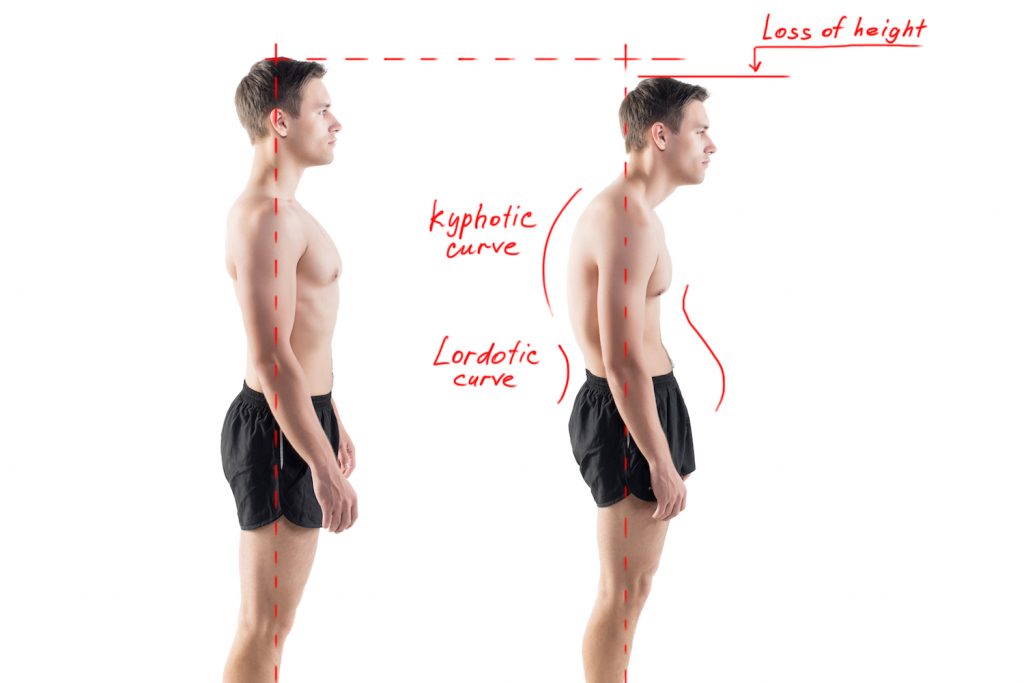1) Improve Your Posture
There are three curves in your spine: cervical, thoracic, and lumbar. The curves help balance the weight distribution of your body and minimize a negative impact on your spine while partaking in various activities. Let’s use running as an example: The feet pound the ground with each stride, sending a force up into your body. Your spine absorbs the pounding force from running the best when your body is in an optimal posture. This means maintaining a “backward C” shaped curve in your neck and low back. In the long run, good posture will help prevent chronic pain from developing and accelerated spinal degeneration from occurring.
2) Stretch Daily
Tight muscles occur as a result of repetitive usage of the same body part or due to long periods of time spent with your body in the same position. Routine stretches help prevent the muscles from becoming tight and developing chronic problems. Remember to stretch everyday to help keep the pain away.
3) Strengthen Your Back And Neck Muscles
The muscles of your neck and back play an integral role in stabilizing your spine. When imbalances in the musculature start to develop, then it opens the door to future spinal problems. A classic example of this is a person walking hunched forward at the neck with the shoulders rounded forward. This occurs, in part, to weak spinal erector muscles whose function is to hold the head upright.
4) Exercise Regularly For Mobile Joints
As everyone should know, regular exercise is good for your overall physical and mental health. What you may not realize is that exercise helps keep your spine healthy as well. The movements associated with athletic activity allow each part of your body to move in various ranges of motion. Joint fixations, which can lead to pain, are much less likely to occur if exercise is part of a daily routine. Mobility is paramount when it comes to a healthy back.
5) Stay Well Hydrated
The average human body is made up of 55-60% water. Water makes up an important part of your blood, muscles, skin, and intervertebral discs – just to name a few. Staying well hydrated is important for back health because the discs are like sponges and absorb a lot of water. Have you heard someone say that they are taller in the morning? This is true because your discs fill with water at night when your spine is relaxed and doesn’t have the weight of your body compressing it. The more water you take in during the day, the better hydrated your intervertebral discs.
6) Increase Core Strength
Your back and abdominal muscles are commonly referred to together as “your core.” The core muscle group helps maintain stability and balance in your body and support your spine. Your core offers stability to your spine when lifting a heavy object. if you trip over a curb, then your core muscles contract in an effort to help maintain balance and prevent you from falling. If part or all of your core becomes weak, then your body will not be able to adapt well to stresses placed on your body each day. This makes you more susceptible to back sprain/strain injuries.
7) Start From The Ground Up
Your feet have a direct impact on the rest of your body because they help absorb shock with every step you take. Like the foundation of a house, your feet support the weight of everything above them. When a problem develops in your foot and ankle, the subtle change in the way you walk will cause a chain reaction of adjustments to your posture and walking bio-mechanics. These changes can put stress on joints higher up in your body and lead to more serious problems and pain. Ask your chiropractor or foot care specialist if you could benefit from custom foot orthotics and make an investment in supportive and comfortable footwear.
8 ) Keep Your Bones Properly Aligned
Maintaining optimal spinal alignment and mobility are vital in the battle against chronic back pain and preventing tight muscles in the back and extremities. Tight painful muscles can result from your body’s natural defense mechanism against joint misalignment. When a joint becomes misaligned, the body’s natural reaction is to prevent further injury to the area. The muscles “lock down” the area with the intention of maintaining stability in the affected region. The muscles will immediately begin to relax when proper alignment and joint function is restored. Routine spinal check-ups help ensure that your spine is in alignment and that your joints are moving properly.
9) Stay Committed
Maintaining a healthy back is a life-long commitment. Make each of the New Year’s resolutions mentioned above part of your routine. Put in a little effort each day — your back will thank you later.
Source:













